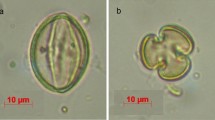Abstract
Flowering phenology of some annonaceous trees and reproductive biology ofPolyalthia littoralis (Annonaceae) were studied. The trees showed various types of flowering phenology within the family. Among them,P. littoralis had hermaphroditic and protogynous flowers, and exhibited continuous flowering throughout the year. Bagged flowers set fruits and seeds comparable to the control. The observations of meiotic stages and the results of castrated tests indicated no possibility of apomictic reproduction. The abscised anthers attached to torus by the extended spiral thickenings, and accomplished self-pollination. Outbreeding possibly occurs, but the following self-pollination guarantees seed set.
Similar content being viewed by others
References
Ashton, P. S., 1969: Speciation among tropical forest tree: some deductions in the light of recent evidence. — Biol. J. Linn. Soc.1: 155–196.
—, 1984: Biosystematics of tropical forest plants: a problem of rare species. — InGrant, W. F., (Ed.): Plant biosystematics, pp. 497–518. Ontario: Academic Press.
Bawa, K. S., 1974: Breeding systems of tree species of a lowland tropical community. — Evolution28: 85–92.
—, 1976: Breeding of tropical hardwoods: an evaluation of bases, current status and future prospects. — InBurley, J., Styles, B. T., (Eds.): Tropical trees: variation, and conservation. — Linn. Soc. Symp. Ser.2: 43–59. — London: Academic Press.
—,Bullock, S. H., Perry, D. R., Coville, R. E., Grayum, M. H., 1985a: Reproductive biology of tropical lowland forest trees. 2. Pollination systems. — Amer. J. Bot.72: 346–356.
—,Perry, D. R., Beach, J. H., 1985b: Reproductive biology of tropical lowland forest trees. 1. Sexual systems and incompatibility mechanisms. — Amer. J. Bot.72: 331–345.
Bernhardt, P., Thien, L. B., 1987: Self-isolation and insect pollination in the primititve angiosperms: new evaluations of older hypotheses. — Pl. Syst. Evol.156: 159–176.
Cronquist, A., 1981: An integrated system of classification of flowering plants. — New York: Columbia University Press.
Danimihardja, S., Notodihardjo, D., 1978: An alphabetical list of plant species cultivated in the Hortus Botanicus Bogoriensis. — Bogor: Bogor Botanic Gardens, LBN.
Ehrendorfer, F., 1982: Speciation patterns in woody angiosperms of tropical origin. — InBarigozzi, C., (Ed.); Mechanisms of speciation, pp. 479–509. — New York: Liss.
Endress, P. K., 1985: Stamenabszission und Pollenpräsentation beiAnnonaceae. — Flora176: 95–98.
Federov, An. A., 1966: The structure of the tropical rain forest and speciation in the humid tropics. — J. Ecol.54: 1–11.
Gazit, S., Galon, I., Podoler, H., 1982: The role of nitidulid beetles in natural pollination ofAnnona in Israel. — J. Amer. Soc. Hort. Sci.107: 849–852.
Gottsberger, G., 1970: Beiträge zur Biologie von Annonaceen-Blüten. — Österr. Bot. Z.118: 237–279.
—, 1986: Some pollination strategies in neotropical savannas and forest. — Pl. Syst. Evol.152: 29–45.
Kato, M., Ichino, T., Hotta, M., Abbas, I., Okada, H. 1989: Flower visitors of 32 plant species in West Sumatra. — InHotta, M., (Ed.): Diversity and plant—animal interaction in equatorial rain forests, pp. 15–31. — Sumatra Nature Study (Botany), Kagoshima University.
Kaul, R. B., Abbe, E. C., Abbe, L. B., 1986: Reproductive phenology of the oak family (Fagaceae) in the lowland rain forests of Borneo. — Biotropica13: 51–55.
Kaur, A., Ha, C. O., Jong, K., Sands, V. E., Chan, H. T., Soepadmo, E., Ashton, P. S., 1978: Apomixis may be widespread among trees of the climax rain forest. — Nature271: 440–442.
Kessler, P. J. A., 1988: Revision der GattungOrophea Blume (Annonaceae). — Blumea33: 1–80.
Lamoureux, C. H., 1975: Phenology and floral biology ofMonodora myristica (Annonaceae) in Bogor, Indonesia. — Ann. Bogor.6: 1–25.
Le Thomas, A., 1980: Ultrastructural characters of the pollen grains of AfricanAnnonaceae and their significance for the phylogeny of primitive angiosperms. 1. — Pollen & Spores23: 5–36.
—, 1981: Ultrastructural characters of the pollen grains of AfricanAnnonaceae and their significance for the phylogeny of primitive angiosperms. 2. — Pollen & Spores23: 267–342.
Maas, P. J. M., Westra, L. Y. T., (Eds.) 1984: Studies inAnnonaceae. 2. A monograph of the genusAnaxagorea A. St. Hil. 1, 2. — Bot. Jahrb. Syst.105: 73–134, 145–204.
McClure, H. E., 1966: Flowering, fruiting and animals in the canopy of a tropical rain forest. — Malay For.29: 182–203.
Medway, L., 1972: Phenology of a tropical rain forest in Malaya. — Biol. J. Linn. Soc.4: 117–146.
Morawetz, W., 1984: Pollination and dispersal. — InMaas, P. J. M., Westra, L. Y. T., (Eds.): Studies inAnnonaceae. 2. A monograph of the genusAnaxagorea A. St. Hil. 1. — Bot. Jahrb. Syst.105: 95.
—, 1986: Remarks on karyological differentiation patterns in tropical woody plants. — Pl. Syst. Evol.152: 49–100.
—, 1988: Karyosystematics and evolution of AustralianAnnonaceae as compared withEupomatiaceae, Himantandraceae, andAustrobaileyaceae. — Pl. Syst. Evol.159: 49–79.
Okada, H., 1987: A report of the botanical expedition to Papua New Guinea during 29th July and 2nd September, 1985. — Sci. Rep., Col. Gen. Educ. Osaka Univ.36: 7–32.
—,Ueda, K., 1984: Cytotaxonomical studies on AsianAnnonaceae. — Pl. Syst. Evol.144: 165–177.
Van Steenis, C. G. G. J., 1969: Plant speciation in Malesia with special reference to the theory of non-adaptive, saltatory evolution. — Biol. J. Linn. Soc.1: 97–133.
Waha, M., Hesse, M., 1988: Aperture types withinSapranthus andPolyalthia (Annonaceae). — Pl. Syst. Evol.161: 135–146.
Willson, M. F., Schemske, D. W., 1980: Pollinator limitation, fruit production and floral display in Pawpaw (Asimina triloba). — Bull. Torrey Bot. Club107: 401–408.
Author information
Authors and Affiliations
Rights and permissions
About this article
Cite this article
Okada, H. Reproductive biology ofPolyalthia littoralis (Annonaceae). Pl Syst Evol 170, 237–245 (1990). https://doi.org/10.1007/BF00937707
Received:
Revised:
Issue Date:
DOI: https://doi.org/10.1007/BF00937707




